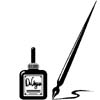|
|
|||||
 |
 |
 |
 |
 |
 |
| Portfolio Presentation | Participate in Negotiations | Instructional Design | Courseware Documentation | Manage a Project | |
|
|
|||||
 |
 |
 |
 |
 |
 |
| Portfolio Presentation | Participate in Negotiations | Instructional Design | Courseware Documentation | Manage a Project | |
| What is a Podcast? from: Wikipedia Podcasting is the method of distributing multimedia files, such as audio programs or music videos, over the Internet using either the RSS or Atom syndication formats, for playback on mobile devices and personal computers. The term podcast, like 'radio', can mean both the content and the method of delivery. The host or author of a podcast is often called a podcaster. Podcasters' web sites may also offer direct download or streaming of their files; a podcast however is distinguished by its ability to be downloaded automatically using software capable of reading RSS or Atom feeds. Usually a podcast features one type of 'show', with new episodes released either sporadically or at planned intervals such as daily or weekly. In addition, there are podcast networks that feature multiple shows on the same feed. Why Podcast? How to Podcast. In the diagram below the developer starts by recording the file to be podcast. The file format should be mp3. The file can then be either uploaded to a website that may be a podcast directory or to host web service such as FileMobile. A link to the podcast's file can then be established from the podcast's directory website or a blog or an aggregator such as iTunes or Feedster. Clicking on the podcast link in the website directory or blog will play the podcast from its stored location. Access to regularly produced podcasts can be simplified by using one of the many free aggregator webservices that enable subscriptions to be established that will provide notifications when new podcasts are available and in the case of iTunes automatically download the podcast to an MP3 player when it is next connected to the aggregator. Subscription to a syndicate of podcast sites (websites and blogs) is achieved via a file known as an RSS FEED. The file is coded in the XML language and is stored in a directory with the HTML file that identifies the location of the podcast files. The RSS feed defines a channel between the aggregator and the podcast. It provides titles for the feed itself, the items it contains and the website addresses for the locations of files referenced in each item (.html and .mp3). The feed includes an enclosure with details of the podcast's mp3 file e.g. size, location, type. Here is an example of an RSS feed's XML file.
<?xml version="1.0"?>
<rss version="2.0">
<channel>
<title>Tonys Podcasts</title>
<link>http://podtafe.tripod.com</link>
<description>A directory of podcasts for
use by TAFE studens</description>
<language>en-us</language>
<copyright>Copyright 2006</copyright>
<lastBuildDate>Thu, 6 Jul 2006 05:33:39
GMT</lastBuildDate>
<generator>tdscripts.com Podcast
Generator</generator>
<webMaster>tonytafe@mail.com</webMaster>
<ttl>1</ttl>
<item>
<title>An Introduction to Subject
A</title>
<description>An overiew of the activities
for subject A</description>
<pubDate>Thu, 6 Jul 2006 05:33:39 GMT</pubDate>
<enclosure url="http://podtafe.tripod.com/test2mp3.mp3"
length="308454" type="audio/mpeg"/>
</item>
</channel>
</rss>
|